1) What is your Number 1 priority to improve the livability of Lynn Valley?
LITTLE: We are all affected on a daily basis by our traffic challenges, and while a solution to the bridge is years away, I am fighting for improved bus services today. I have been successful getting a Lonsdale – Lynn Valley rapid bus included in Translink’s top priorities and hope to finally see frequent transit service to the centre.
BOND: Improving sustainable transportation options will improve everyone’s health and wellbeing. This includes more transit options, more car shares, and more safe walking/cycling/rolling options.
BACK: I definitely want to see the completion of the artificial turf field at Argyle within the next six months, it’s taken far too long to get this project done. I would also like to see the DNV look to refresh and upgrade some of the washroom facilities within a few Lynn Valley parks, many of which are starting to show their age.
MALLIN: It is difficult to just choose one thing, as we need a whole spectrum of solutions working together to improve livability! If I had to choose though, it would be affordable housing. This means focused policies to improve the housing situation here. We need to define what affordability means. We need to create policies that encourage missing middle housing, and allow for multigenerational housing, duplexes, triplexes and coach houses much more easily. We need more affordable ownership options, especially for first time buyers and downsizing seniors. We need a short-term rental policy and we need more social housing.
TOFIGH: Sustainable peace and comfort are my Number 1 priority. We need more and more EV stations in our community to help and protect our environment and encourage people to use electric and plug-in hybrid vehicles. Intelligence and active public transportation system and taking out of the road of the vehicles with abnormal noises bring peace and comfort to our community.
ROBINS: My number 1 priority is to find ways to add options to modernize and update our zoning bylaws. While single family home restrictions had a place over a half century ago, new realities demand smaller, more efficient homes, options for ways to build duplexes or triplexes, and add coach houses.
2) What do you think is the biggest challenge facing Lynn Valley (at the municipal level)?
LITTLE: Retaining and growing the affordable options in the community. Lynn Valley has had great co-op and townhouse options mixed into our primarily single family area, but those places are under threat of redevelopment. In some cases, redevelopment is the way to go and we need a council that will maximize the affordability of the new units, but we also have to have the wisdom to know when to reject a proposal that may exacerbate our traffic problems.
BOND: We’re building a better world for our kids by addressing 21st century problems with 21st century solutions, but change is difficult. A few priorities I’ve heard from residents are: more safe and sustainable transportation options, more urban green space, a playground in the Town Centre, more diverse small businesses to support the local community, and more rental and affordable housing options – particularly for people on low and fixed incomes. The climate crisis is a top concern for all DNV residents. It’s not a separate issue, it’s the lens that underpins all decisions.
BACK: Since the start of the pandemic, all of our parks such as Lynn Canyon Park, have seen a big increase in the number of visitors that are frequenting them every weekend. While this can present challenges, I also think their are opportunities to capitalize on this increase in visitors. I would like to see us create some more community events that may cater to residents and visitors alike, things like farmers markets, small scale community festivals, that will work for young families and also support small businesses.
MALLIN: Traffic is the biggest day to day challenge here. There are only a few ways in and out of Lynn Valley and, if there is serious traffic, there is really no point of even trying to leave. Lynn Valley is flush with amazing natural amenities that people flock here to use. We cannot expand roads or parking lots, there is really no space for that. We can focus on building public and active transit to our most popular destinations to try to get people out of cars. We need to build smarter bike lanes that utilize side roads and trails.
TOFIGH: As a resident of Lynn Valley, I think housing, EV stations and traffic are the biggest challenges.
ROBINS: The biggest challenge is traffic. We’re a car-centric community simply because of the distances we need to travel for the basics. The next council will need to accelerate non-car travel routes (walking and cycling) that are safe for everyone.
3) New builds typically seem to clear-cut all trees. Lynn Valley will be barren if that trend continues. What are your views on the forested-character of Lynn Valley?
LITTLE: We have made it a priority to protect trees on publicly owned lands, and we have put in some of the toughest tree replacement requirements on private property. Ultimately it is a balance, we want trees to be healthy, but we also must manage fire risk by creating defensible space between our homes and the forest canopies. We are the biggest risks when it comes to forest fire, and we need to be proactive about giving the forest a fighting chance.
BOND: The North Shore forests are beloved by all and a healthy urban tree canopy is a critical part of community well being. The forested nature of Lynn Valley has changed since it was first logged more than a century ago. As we build a future for our kids, it will continue to change. With a long-term Biodiversity Strategy that is currently underway, we can identify ecosystems that need to be protected, restored, and regenerated. Many of our tree species will not survive drought and increasing temperatures from climate change and we need to be planning now for generations to come.
BACK: With the hot summers we have had in recent years, it has made it very clear that we need to protect our tree canopy across the community. This trend is one we are seeing with new builds across the DNV and one that this Council has tried to address in a number of ways, most recently by enhancing our Tree Bylaw to make it more difficult for homebuilders to clear a lot in the same way. In 2021, the Urban Tree Canopy Project was launched, which encourages residents to plant new trees on their properties by providing them with up to three free trees. It’s been a tremendous success with a total of 239 native plants planted in 146 different properties in the first year of the program.
MALLIN: I do not think we are going to see a future where Lynn Valley will be barren, but we need to make sure that developments respect the character of Lynn Valley, especially regarding our natural landscape. Developments should be built in a way that compliment the forests and, ideally, add to the green spaces we have. There are many creative solutions that should be used more, like green roofs, vertical gardens along walls and more/updated urban trails. The DNV does have a new urban canopy program, and more could be done to advertise it to folks here.
TOFIGH: Everyone who like Lynn Valley is due to the green canopy. We have to protect our green community. Great communities require great leaders, and I think if we have great leaders in our community, especially in Lynn Valley, we are going to stop the cut the trees. If a builder wants to cut a tree, they must plant another tree in our community. Although we cannot stop the growth, we can change our policy, and if we need more buildings, we can change our policy from vertical buildings to horizontal buildings and small buildings.
ROBINS: There are some developments where large and well established trees have been chopped down for the convenience of the owner. I would like to see tree bylaws meet or exceed those of the City of North Vancouver to maximize our canopy. We are home to a lot of wild animals and birds and it is our responsibility to be stewards of these places.
4) What are your goals to support pedestrian safety and safe access to schools?
LITTLE: We have been supportive of both funding and maintaining better trail connections throughout Lynn Valley, and supporting our safe routes to schools plans with hard infrastructure such as crossing improvements and sidewalks. I expect that to continue, but in spaces like Mountain Highway specifically, we have not left enough of a boulevard to widen the sidewalks without costly land acquisitions, so we are looking at alternatives.
BOND: Lynn Valley around the town centre has a great geography for getting around by foot or on a bike. Focussing on safe active routes to school is a top-priority. Small things, like upgrading many of the paths that criss-cross the creeks and green spaces with curb-cuts and wider bridges can make a big difference in people being able to get to schools and shopping while staying off the major roads. Where routes cross major roads like Lynn Valley, Mountain Hwy and 29th, narrowing the distance people have to cross will make crossings safer.
BACK: One of my top priorities as a Councillor has been to make the necessary investments in active transportation to make it safer for everyone to get around the community by walking or riding a bike. As the parent of two very young kids, I now have a different perspective on this and I am more motivated than ever to push for the necessary changes to road design, particularily around schools, to slow vehicle traffic and make the experience of walking or rolling to school safer and more enjoyable for all. We do have a Safe Routes to School program which looked at a number of elementary schools across the DNV and identified proposed infrastructure improvements such as new sidewalks to make these routes safer. While Eastview was not one of the schools on this list, I promise to look at what specific improvements can be made around this school.
MALLIN: Wider sidewalks absolutely need to be done. We can even combine them with bike lanes in some areas, as bike lanes should be elevated and separated from traffic by more than just plastic dividers. These should be seen as mobility lanes, where people with scooters or wheelchairs can also easily use them. Every crosswalk along a school route should be elevated as a speed hump as well. We should also look at banning right turns on red lights in certain high pedestrian intersections.
TOFIGH: I have a couple of plans. We need active and smart public transportation, and all bus stops need shelter and benches. In our community, we do not have a safe route for cyclists. We need to encourage people in our community to use bicycles, carpools, and public transportation. Still, the infrastructure must be built by the district, and I have some plans to create the infrastructure and encourage people to believe in this system.
ROBINS: My goals for supporting the safety of anyone not in a car are very important to me. I would like to see at least 6 foot setbacks for cars at all cross walks, curbs painted red to indicate where cars cannot park at intersections, bulges at cross walks to prevent passing a stopped car, and less permanent parking on roads around schools.
5) What are your priorities for traffic lanes? How will you prioritize bus lanes, motor vehicle lanes, parking and active transpiration (bike) lanes? Do you have a vision for mass transit coming to Lynn Valley?
LITTLE: I have been fighting for Rapid Bus to come to Lynn Valley and I am happy to report that in our July meeting, the North Shore Mayors were able to work together and get a commitment from the region for a Rapid Bus that will connect the Seabus to Lynn Valley 19 hrs /day, 7 days a week, every 8 minutes.
BOND: As population slowly increases, competition is inevitable for limited road space. We will bring transportation into the 21st century, delivering solutions proven to work for neighbourhoods like Lynn Valley. It often makes sense to drive, whether in your own vehicle or car share. For short trips, it’s often quicker and less stressful to move around on bikes and by foot. We need to make walking and biking within Lynn Valley feel safer and more comfortable for those short everyday trips, while ensuring frequent and reliable transit from Lynn Valley to connect to the broader network, including Bus Rapid Transit.
BACK: Increased bus rapid transit on the North Shore is park of Translink’s 10-Year Plan and, specifically, a RapidBus connection between Lynn Valley and Downtown Vancouver. This service will greatly increase the frequency and reliability of transit in and out of Lynn Valley. I think the Lynn Valley Road Active Transportation Project, which is now under construction, will provide a number of safety improvements for people walking or rolling through this corridor. I also look forward to the eventual build out of the Kirkstone Park to Salop Trail, which will provide a safe and continuous cycling connection from Lynn Valley Town Centre to Lynn Creek Town
I will also continue to advocate that we push MoTI to build a safe connection on the south side of Lynn Valley Road, where it crosses under Highway 1. When it comes to balancing the various demands for road space, I generally am not supportive of having on-street parking on arterial roads, as these are often the most direct routes to provide active transportation connections between town centres. Where it does not compromise user’s safety, parking can in some cases be accomodated with parking pockets and drop off zones.
MALLIN: I would like to see bike lane focus shift to side streets more, and some of our trails that can be widened and used for that. I fully endorse work needed to complete Translink’s 10-year plan which may involve better bus access to the Ironworkers bridge. Bus Rapid Transit seems like a great system that can be quickly and cheaply deployed and hopefully provide some relief here, and I will always lobby for more transit options. Parking lots in top destinations should have a few more spots allocated for handicapped parking as well.
TOFIGH: Unfortunately, during the past years, by increasing the population and street vehicles, no attention has been made to the difficulties in the future. As of today, we do not have any safe routes for cyclists or bicycle riders. Around the Lynn Valley center, during the past two years, several high-rise buildings have been finished, and there is no parking for vehicles in the street around these building. It seems that during past years, they just thought about creating business for others instead of thinking for our community!
ROBINS: This is a complex issue and the district staff should be tasked with researching and suggesting solutions to integrate all modes smoothly. This needs bold leadership at the council level to empower staff to make recommendations.
6) An issue of concern is “missing-middle” homes: townhomes, duplexes, row homes, etc – something between towers and single-family homes. Another concern is that recent developments have reduced the diversity of local businesses. What is your development vision for the Lynn Valley and the District?
LITTLE: Modest, strategic growth. Lynn Valley doesn’t have the same road network as our Seylynn and Lions Gate town centers, so we need to make sure that the housing we attract serves the local community. While there may be some sensitive infill as highlighted in our OCP, the bulk of the new units in LV should be in the town center.
BOND: I have consistently advocated for more housing options to meet the changing needs of our residents. Most homes were built over 50 years ago. We live, work, commute, socialize and recreate in different and more diverse ways than we did in the 1960s.There are not enough missing-middle homes in Lynn Valley to address this evolution. By embracing diverse housing we create opportunities for young people to stay in the neighbourhood they grew up in, established residents to age in place in an accessible home, and families to adapt property they already own to support multi-generational living.
BACK: I have lived in Lynn Valley my whole life and have had a front row seat to the changes which have taken place over the years. Overall, I think the Lynn Valley Village and revitlization of Lynn Valley Centre have been been a positive evolution for the area, but I think there is much more we could do. There has been a noticable change in the demographics of Lynn Valley in recent years, as more and more young families have moved to the area. I would like to see a greater diversity of smaller, independantly owned businesses, as well as more restaurants and – dare I say – maybe even a craft brewery of our own here one day! I would also like to see a new park in the heart of Lynn Valley that features playspace for kids, as well as an off leash area for dogs.
MALLIN: Missing middle housing is a top priority of mine. It is a simple solution to get some more housing diversity without significant change to a neighbourhood or lengthy construction. Missing middle options should be more heavily favoured around large parks or community centres, as the large yards of a single-family neighbourhood are less needed there. Transit oriented housing needs to be prioritized, especially with reduced parking requirements. It blows my mind how little housing there is along Marine Drive, especially when there is a bus along there every 5 minutes (or less sometimes!).
TOFIGH: The couple of aspects must be focused and work on it. We have to ask small and middle size developers and contractors to play. The main and only player is large contractors. We have to support small businesses to establish their business in our community. If the small and middle contractor and developers are coming to play, we will have much more duplex, triplex and row homes, I promise.
ROBINS: The District can follow in the footsteps of other progressive municipalities and give flexibility to renovators and builders through an update of planning and zoning regulations. Our zoning bylaws were initially written in 1965 and reflect the restrictions on housing types from over half a century ago. Since our homes have become a commodity to buy and sell, entering the market is nearly impossible for most middle-income earners. We have no choice but to add diverse housing that people are demanding. I will strongly support a wide range of housing options including multiplex, co-op, and rental housing that lets younger people into the district through thoughtful densification to build stronger communities.
7) Residents have expressed concerns that District (and North Shore) infrastructure is being outstripped by development with transportation, green spaces and healthcare over capacity. What are your views on this issue?
LITTLE: We haven’t had an increase in lanes to the North Shore since 1968. We desperately need an agreement between the District, the Province and the Federal Government for the eventual replacement of the Iron Workers Memorial Bridge. Our view is that the bridge has less than 20 years of full use, the Province thinks it is more like 40yrs. We have to get everyone in the room and craft a plan for that vital regional connection.
BOND: Concerns about infrastructure are not unique to Lynn Valley, the District or the North Shore. The healthcare crisis is felt by communities small and large across the Province. Our common frustration of being part of traffic from 2pm onwards, with a long line of people who work on the North Shore trying to get home to Langley, Maple Ridge or beyond, will only get worse if we don’t provide more options for people to live here. We can create the conditions where healthcare professionals, contractors and others can live here, avoid the punishing commute and become part of our community.
BACK: I think we always have to be looking at the impact that new development has on our exisitng infrastructre and I would say, on the whole, the DNV has done a good job of accounting for this in our Official Community Plan and by regularily communicating with our various partner agencies. Parks and natural spaces have always been a defining characteristic of this area, and I would certainly support invesments in our existing parks, as well as looking to create new parks in some cases. I think planning for the future also highlights the importance of making sure we continue to have strong collaborative relationships with partners like Vancouver Coastal Health and School District #44, to make sure that all of the key community needs are looked after today and for many years to come.
MALLIN: This pandemic has really highlighted the importance of access to healthcare and recreation. We need to zone spaces for healthcare, or mandate new developments to reserve space for healthcare options as getting to the UPCC or a clinic on Lonsdale is not always possible or easy. This should no longer be seen as only a provincial responsibility – municipalities need to step up or be left behind. More walkable communities are needed, with a complete spectrum of businesses and services available, from nice restaurants to entertainment options. The District needs to step up to support this.
TOFIGH: I disagree that infrastructure is being outstripped now. But if any changes not happened and the district does not pay attention carefully to the green spaces, healthcare, traffic and housing issues, we will not have any infrastructure in any matter shortly.
ROBINS: The District has been proactive when it comes to infrastructure, however, I would like to see a greater focus on safer routes for people who do not drive. Green spaces are what make the North Shore so special, and we must do all we can to protect and preserve these space. Healthcare, according to professionals I speak with, is suffering from front-line worker burnout and a lack of affordable homes for nurses and staff. I believe smaller, more affordable homes can go a long way to help this.
 “I want to serve people with compassion,” she said. “As I became a single mom, I was using the legal system and I know how hard it is. I knew I wanted to help people. As a notary, I can be patient and compassionate.”
“I want to serve people with compassion,” she said. “As I became a single mom, I was using the legal system and I know how hard it is. I knew I wanted to help people. As a notary, I can be patient and compassionate.”
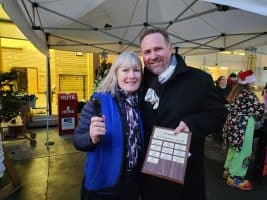

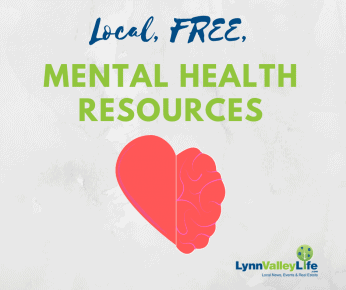 Programs to support families and kids
Programs to support families and kids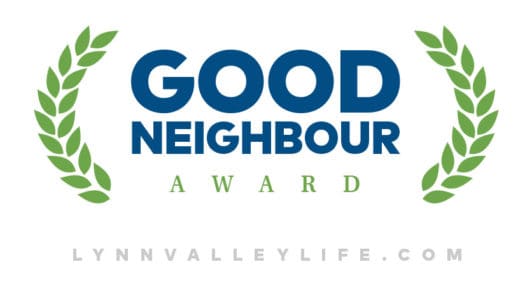 Day-to-day we try to gather interesting and innovative stories about Lynn Valley but one thing that can be missed is the quietest of stories. The good that goes on in our neighborhood every day – often unnoticed beyond the person or the organization helped.
Day-to-day we try to gather interesting and innovative stories about Lynn Valley but one thing that can be missed is the quietest of stories. The good that goes on in our neighborhood every day – often unnoticed beyond the person or the organization helped. 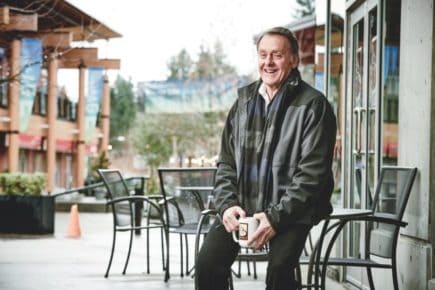 The Good Neighbour Award has been going strong since 2012. We receive heartfelt nominations – some short, some long. Check out some previous winners and read their stories – we have an exceptional community! Last year we recognized the great
The Good Neighbour Award has been going strong since 2012. We receive heartfelt nominations – some short, some long. Check out some previous winners and read their stories – we have an exceptional community! Last year we recognized the great 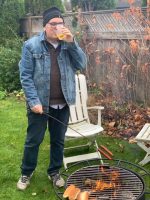
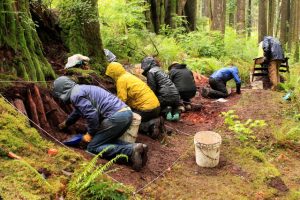 “North America, British Columbia, Metro Vancouver are fascinating,” he said. “There is so much archaeology to study here. The western, European, colonial view that Indigenous history is not that interesting is completely wrong – it’s fascinating. It goes back thousands of years. The entirety of archaeology in BC is so rich, from thousands of years ago to contemporary times.”
“North America, British Columbia, Metro Vancouver are fascinating,” he said. “There is so much archaeology to study here. The western, European, colonial view that Indigenous history is not that interesting is completely wrong – it’s fascinating. It goes back thousands of years. The entirety of archaeology in BC is so rich, from thousands of years ago to contemporary times.”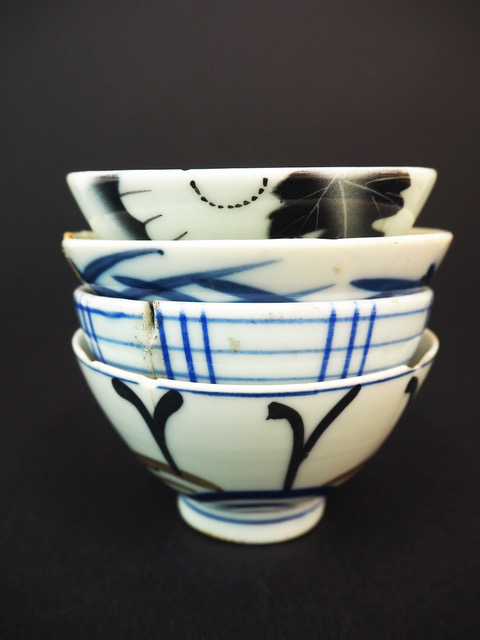
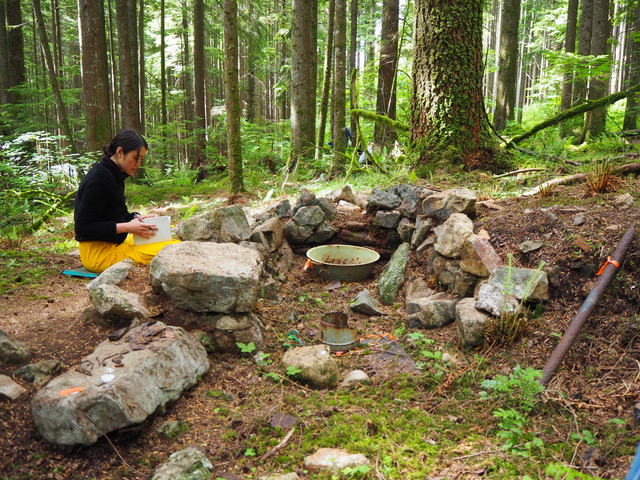


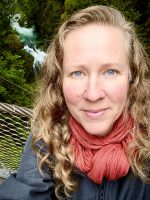 “It is like painting with thread and fabric,” she said. “People think of fabric as being for useful things, like tablecloths, bed coverings, clothing. Seeing textiles on the wall in the same sort of format as paintings can put them in that ‘art’ category more than the ‘craft’ – which are more useful artifacts. It’s a very tactile hands-on material but it’s displayed in a more artful way.”
“It is like painting with thread and fabric,” she said. “People think of fabric as being for useful things, like tablecloths, bed coverings, clothing. Seeing textiles on the wall in the same sort of format as paintings can put them in that ‘art’ category more than the ‘craft’ – which are more useful artifacts. It’s a very tactile hands-on material but it’s displayed in a more artful way.”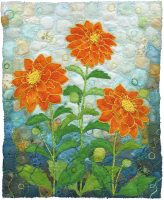 “Most of the pieces in this exhibit were completed during the pandemic, I was searching for beauty in a time of uncertainty and staying close to home,” she said. “I have always been drawn to flowers and nature. I have been drawn to botanical gardens. I only have a small balcony garden myself, so I am jealous of larger spaces to grow flowers – it’s an endless resource of inspiration. There are so many possibilities.”
“Most of the pieces in this exhibit were completed during the pandemic, I was searching for beauty in a time of uncertainty and staying close to home,” she said. “I have always been drawn to flowers and nature. I have been drawn to botanical gardens. I only have a small balcony garden myself, so I am jealous of larger spaces to grow flowers – it’s an endless resource of inspiration. There are so many possibilities.” She hopes the use of thread and fabric in unexpected ways delights observers.
She hopes the use of thread and fabric in unexpected ways delights observers.  Mike Little,
Mike Little,  Mathew Bond,
Mathew Bond,  Jordan Back,
Jordan Back,  Ellison Mallin,
Ellison Mallin,  Thomas Tofigh,
Thomas Tofigh,  Greg Robins,
Greg Robins,  Linda Munro,
Linda Munro, 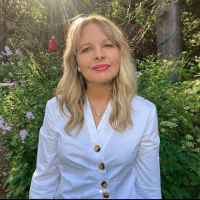 “I was so privileged to move here during the pandemic,” she said between live interviews for CBC about September’s Hurricane Fiona. “It was finding solace and falling in love with these trails when that was all we had. I feel lucky that I get to live here and share that with our audience.”
“I was so privileged to move here during the pandemic,” she said between live interviews for CBC about September’s Hurricane Fiona. “It was finding solace and falling in love with these trails when that was all we had. I feel lucky that I get to live here and share that with our audience.” “We are out every single day rain or shine. I have always been someone who isn’t afraid to go out in it – and moving from Ontario to BC – British Columbians are better at gearing up and getting out,” she said.
“We are out every single day rain or shine. I have always been someone who isn’t afraid to go out in it – and moving from Ontario to BC – British Columbians are better at gearing up and getting out,” she said. 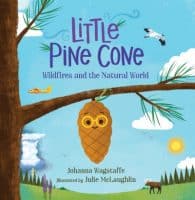 “I knew after the back-to-back wildfire seasons of 2016-2017 that this was the next topic. I saw climate anxiety coming out in the students I was talking to – in a way I never had before,” she said. “I wanted to find a way to connect with them. Anthropomorphizing a pine cone is how I did it after it worked so well with a cloud in my earlier book. There are natural processes, humans have disrupted some but these extreme weather events aren’t all ‘bad.’ Climate change is enhancing them but there are good things about these cycles as well.”
“I knew after the back-to-back wildfire seasons of 2016-2017 that this was the next topic. I saw climate anxiety coming out in the students I was talking to – in a way I never had before,” she said. “I wanted to find a way to connect with them. Anthropomorphizing a pine cone is how I did it after it worked so well with a cloud in my earlier book. There are natural processes, humans have disrupted some but these extreme weather events aren’t all ‘bad.’ Climate change is enhancing them but there are good things about these cycles as well.”
 “If attendees are unsure of what to ask, they can seek guidance from our staff so they can have a meaningful face-to-face conversation,” said van Dyk. “We will also have information on how to vote for folks who may have not cast their ballot before. This event is about creating opportunities for community connection and supporting lifelong learning. NVDPL staff are experts at guiding patrons to find the information they need and this event will be no different. To encourage conversations between candidates and votes, we will provide a wide variety of sample conversations to inspire dialogue.”
“If attendees are unsure of what to ask, they can seek guidance from our staff so they can have a meaningful face-to-face conversation,” said van Dyk. “We will also have information on how to vote for folks who may have not cast their ballot before. This event is about creating opportunities for community connection and supporting lifelong learning. NVDPL staff are experts at guiding patrons to find the information they need and this event will be no different. To encourage conversations between candidates and votes, we will provide a wide variety of sample conversations to inspire dialogue.”